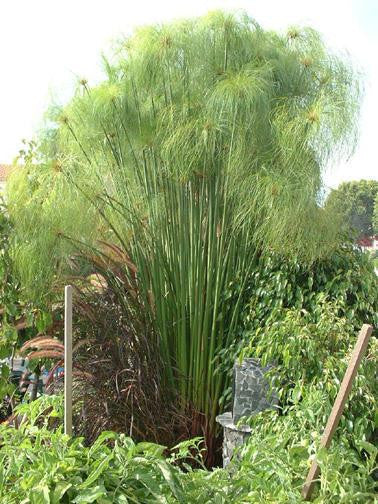Ancient Egypt has the most well known documentation of the virtues of the Papyrus plant; largely because of the use they made of the fibers from the stem of this warm weather, water loving plant. From this plant came the first known “paper” – scrolls of it, made from these fibers. They carried the knowledge of their times into our modern world. Scrolls of that era can be read today, and continue to be one of the best resources for understanding ancient times. An excerpt from information provided by Earlham College reveals a curious point about values perceived of that technology:
An excerpt from information provided by Earlham College reveals a curious point about values perceived of that technology:
The use of papyrus as a writing material goes back to extreme antiquity. The oldest written papyrus known to be in existence is, according to Kenyon (The Paleography of Greek Papyri, Oxford, 1899), an account-sheet belonging to the reign of the Egyptian king Assa, which is conjecturally dated circa 2600 B.C.The first recorded purchase of papyri by European visitors to Egypt was in 1778. In that year a nameless dealer in antiquities bought from some peasants a papyrus roll of documents from the year 191 – 192 A.D., and looked on while they set fire to fifty or so others simply to enjoy the aromatic smoke that was produced. Since that date an enormous quantity of inscribed papyri in all possible languages, of ages varying from a thousand to nearly five thousand years, have been recovered from the magic soil of the ancient seats of civilisation in the Nile Valley. From about 1820 to 1840 the museums of Europe acquired quite a respectable number of papyri from Memphis and Letopolis in Middle Egypt, and from This, Panopolis, Thebes, Hermonthis, Elephantine, and Syene in Upper Egypt. Not many scholars took any notice of them at first, and only a very few read and profited by them.
How could such a marvel have been taken for granted? Egyptians used this technology (ancient IT) about 4000 years before Europeans knew of it. When they finally did make note, it was so common and abundant in Egypt that they were burning scrolls of it for entertainment.
Papyrus remains with us in our modern day world. If not for paper, then just for the unusual beauty that Dr. Suess would most appreciate.
Plant Papyrus in a mud puddle and admire it until temperatures drop below around 40 degrees. It is a durable bog plant, though it does need the warm temperatures. With minimal effort, it can be kept going until spring by taking stem cuttings to root in a wet medium, or dig up planter full. Either way, place it inside by a sunny window.

